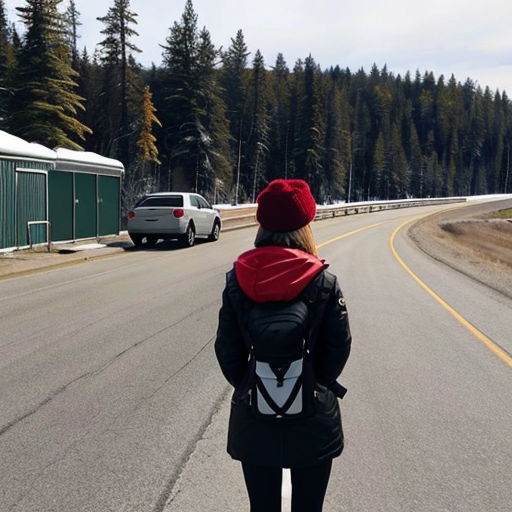Executive Chutes and Ladders: Gender Based Violence Asylees and Equal Protection Violations at the Northern Border
By Faith Orr | Staff Editor
February 16, 2024
—
After enduring 15 years of repeated physical and sexual violence at the hands of her now ex-husband, Ms. A-B- moved with her children to a new town in El Salvador. Her ex found her. He raped her. She filed for divorce. But this was not enough. Death threats came next. “Be very careful, you don’t know where the bullets will land.”[1] These were the words of her brother-in-law warning her against fleeing.[2] Fearing for her life and that of her children, Ms. A-B- had no choice but to leave her home country and seek asylum in the United States.
Ms. A-B-’s asylum story is only a drop in the bucket of the gender based violence (GBV) occurring globally. GBV knows no jurisdictional limits. For many, seeking asylum is the only way out.
Yet, last spring, the U.S. and Canada changed the rules of the asylum game at the Northern border—severely restricting asylum access in Canada and violating GBV claimants’ equal protection rights under Canadian law. How did we get here? Let’s take a step back.
In 2002, the Martin-Bush administrations created the Safe Third Country Agreement (STCA) to address the flow of migrants at the Northern border.[3] The STCA is a bilateral treaty mandating that asylees seek asylum in the first “safe” country in which they land. If you first touch foot in the United States, you cannot continue to travel up to Canada to start a new asylum claim there, and vice-versa. Doing so will trigger removal back down to the United States. The 2002 STCA had an important carve-out: those entering Canada from the United States via an unofficial port of entry would not be subject to removal, allowing them to continue their claim in Canada.[4]
In March 2023, the Trudeau-Biden administrations expanded the STCA to close the irregular entry carve out, spanning its jurisdiction across the entire Northern border.[5] Practically speaking, any asylee who has first arrived in the United States is no longer eligible to make a claim in Canada, regardless of how they physically entered Canada. This jurisdictional expansion poses a unique situation for GBV claimants at the Northern border.
GBV is the main reason women seek asylum in Canada.[6] The majority of these claimants opt for irregular points of entry into the country. This preference stems from the reduced risk of detection by their abusers.[7] A standard asylum application process demands substantial documentation, financial resources, and time—luxuries often beyond the reach of many GBV survivors who need immediate protection.[8]
By expanding the STCA, Canada has violated its own Constitution. The equal protection clause of the Canadian Charter of Rights and Freedoms states that every person on Canadian soil is to be given “equal benefit” of the law.[9] In particular, the Charter provides explicit protection on the basis of sex. GBV falls well within this preview. The legal test for a Canadian equal protection violation is whether the law creates a distinction based on a protected ground (“sex” for our purposes) and if that distinction disadvantages that protected ground by perpetuating a stenotype.[10] The expansion of the STCA does just that. GBV claimants are being denied equal access to have their claim heard in Canada because the United States has subpar adjudication standards for these claims.
Remember Ms. A-B-? Her claim took six years to process. Through the years, her Matter has gone through so many twists, turns, reverses, remands, and vacates, and yet the United States still has no solid guidelines on adjudicating GBV claims.[11] Without these clear standards, GBV claims sit in fragility on the whim of the Attorney General.
In contrast, Canada has a detailed and comprehensive standard for GBV adjudication. In 1993, Canada was the first country to recognize the difficulties of adjudicating GBV claims. So it created the Chairperson’s Guide.[12] This guide compiles extensive sociological, psychological, medical, and legal resources to help adjudicators make a fair and equitable decision on GBV claims which avoids stereotyping and retraumatization.[13] The Guide is comprehensively updated every few years.[14] In many ways, Canada’s GBV processing sets the gold standard.
To remedy this equal protection violation, Canada and the United States must again amend the STCA back to its 2002 version. This will provide more balanced and humanitarian GVB claims without violating basic human rights.
[1] Matter of A-B-, 28 I & N. Dec. 307 (A.G. 2021) (Attorney General Garland Vacating Matter of A-B-).
[2] Id.
[3] Safe Third Country Agreement, Can.-U.S., Dec. 5, 2004, 69 FR 10627.
[4] Id.
[5] Implementation of the 2022 Additional Protocol to the 2002 U.S.-Canada Agreement for Cooperation
in the Examination of Refugee Status Claims from Nationals of Third Countries, Mar. 25, 2023, 88 FR 18227.
[6] Irregular Border Crosser Statistics, Immigr. and Refugee Bd. of Can., https://www.irb-cisr.gc.ca/en/statistics/Pages/Irregular-border-crosser-statistics.aspx (last updated Nov 27, 2023).
[7] Salma Zahid, Asylum-Seekers at Canada’s Border: Report of the Standing Committee on Citizenship and Immigration 18 (2023) (44th Parliament, 1st Session).
[8] Id. at 25.
[9] Canadian Charter of Rights and Freedoms S. 1 c. 1.
[10] Id. at S. 15 c. 1.
[11] A-R-C-G-, 26 I. & N. Dec. 388, 391 (B.I.A. 2014), overruled by A-B- (A-B- I), 27 I. & N. Dec. 316 (A.G. 2018) vacated, 28 I. & N. Dec. 307 (A.G. 2021).
[12] Canadian Immigration and Refugee Board, Women Refugee Claimants Fearing Gender-Related Persecution (Guidelines issued by the Chairperson of the Board in accordance with subsection 65(3) of the Immigration Act) (Mar. 9, 1993).
[13] Id.
[14] Id.

